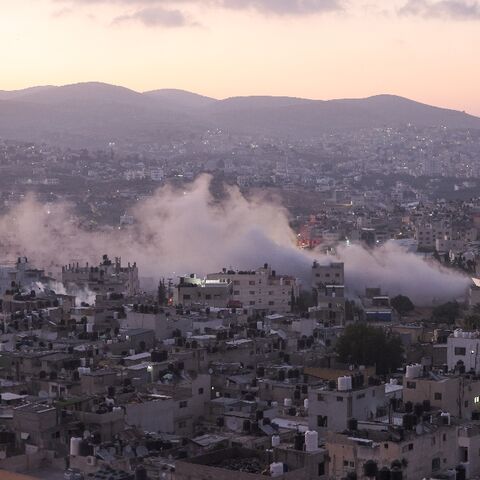DUBAI — Saudi Arabia was ranked the 5th biggest military spender in 2022, jumping from eighth to fifth place in one year and surpassing the United Kingdom, Germany and France.
The kingdom was the only Middle Eastern country to make the top 10 global list, according to a report released on Monday by the Stockholm International Peace Research Institute (SIPRI). It saw military spending increase by 16% to reach an estimated $75 billion, according to the Trends in World Military Expenditure 2022 report by SIPRI.
Total Middle East expenditures reached an estimated $184 billion in 2022, an increase of 3.2% from the year before, mainly due to Saudi Arabia’s significant uptick.
This total does not include the Palestinian territories nor Arabic-speaking North African countries including Egypt, Morocco and Algeria. It also does not include the United Arab Emirates, which has an estimated defense budget worth $23.2 billion in 2023, according to data analytics company Global Data. SIPRI reported that the organization has not acquired data on the United Arab Emirates’ military spending since 2014.
Here are the Middle East countries among SIPRI’s top 40 global military spenders and their global rankings:
Saudi Arabia, $75 billion (5th)
Israel, $23.4 billion (15th)
Qatar, $15.4 billion (20th)
Turkey, $10.6 billion (23rd)
Algeria, $9.1 billion (26th)
Kuwait, $8.2 billion (30th)
Iran, $6.8 billion (34th)
Oman, $5.8 billion (36th)
The 15 largest spenders, which include Saudi Arabia and Israel, accounted for 82% of the world’s military expenditure and $1.842 trillion.
The Middle East also had the highest military burden in 2022, according to SIPRI, with spending making up 3.9% of gross domestic product on average. Europe had the second highest burden at 2.5% and Africa had the third highest at 1.7%.
Diego Lopes da Silva, a senior researcher in SIPRI’s Military Expenditure and Arms Production Program, said the Middle East’s high burden is due to regional conflicts.
“Saudi Arabia continued to lead a military coalition against the Houthis in Yemen. The eight-year-long conflict worsened again in 2022, as missile and air strikes by both sides intensified,” he told Al-Monitor.
In Israel, despite a 2022 drop in military spending, the burden is still high between Israeli military attacks on Palestinian territories along with intensified strikes on Syria.
Middle East countries saw a slight drop in military spending of 0.4% in 2022 compared to the year before that could continue as the region has seen a gradual increase in normalization with states previously considered rivals, particularly countries of the Gulf Cooperation Council (GCC).
Qatar's relations have warmed since 2021 with Saudi Arabia, the UAE, Egypt and Bahrain since the signing of the Al-Ula Declaration in Saudi Arabia in 2021, brokered by the United States and Kuwait.
The Gulf dispute began in June 2017 with the halt of diplomatic ties and a blockade on Qatar by Egypt and fellow GCC countries Saudi Arabia, the UAE and Bahrain.
In March, Saudi Arabia agreed to restore ties with longtime rival Iran and reopen diplomatic missions in a Chinese-brokered deal. The relationship had soured in 2016 following the Saudi execution of revered Shiite cleric Nimr al-Nimr and other events.
Despite these perceived improvements, the results on Middle East military spending will not likely be immediately evident.
“Even if relations improve and the conflicts come to an end, it is very likely that a change in military burden would still take some time to take place,” Lopes da Silva told Al-Monitor. “As a result, the Middle East will likely remain the region with the highest average military burden in 2023,” he added.
Global military spending
World military spending grew for the eighth consecutive year, reaching an all-time high of $2.24 trillion, a 3.7% increase from 2021. The three largest spenders were the United States (39%), China (13%) and Russia (3.9%), which collectively accounted for nearly 56% of global military spending.
Total world military spending accounted for 2.2% of global #GDP in 2022. Global spending grew by 19% over the decade 2013–22 and has risen every year since 2015.#GDAMS2023
Get the full analysis ➡️https://t.co/CUMd384wvl
Catalan ➡️ https://t.co/ZYW3XiTuJl
Spanish ➡️… pic.twitter.com/rTtd2kcd4o— SIPRI (@SIPRIorg) April 24, 2023
Europe saw the sharpest rise in expenditures at 13%, significantly due to Russian and Ukrainian outflow, said SIPRI, which found that the war has strongly influenced the spending of nearby countries.
“The continuous rise in global military expenditure in recent years is a sign that we are living in an increasingly insecure world,’ said Nan Tian, a senior researcher with SIPRI’s Military Expenditure and Arms Production Program.
“States are bolstering military strength in response to a deteriorating security environment, which they do not foresee improving in the near future,” he added.


f0eb.jpg)





